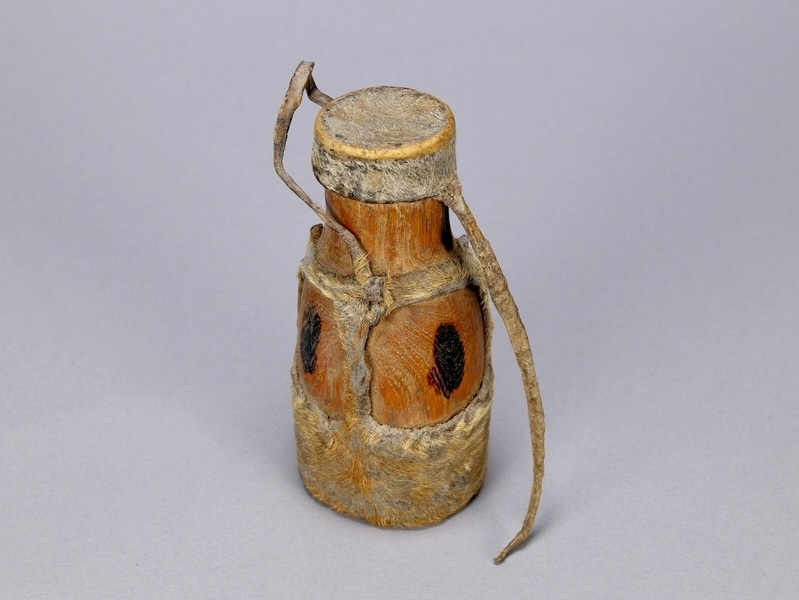Container Item Number: 905/8 a-b from the MOA: University of British Columbia


Description
Brown bottle-shaped container (part a) with skin lid (part b). Skin is stretched across base of wooden container. Near the centre of the container, the skin sections off into five vertically positioned thin strips of skin, creating five panels of exposed wood with dark areas in the centre. The top of the strips are connected by a horizontally positioned strip of skin that is secured by a skin tie. Container is capped with a skin lid (part b) that has a long skin strap that hangs to the side of the container.
History Of Use
Tag with object says: ‘Turkana container used by women for storing animal fat for domestic and cosmetic use'; fat containers are called akgitum or abur. Types of fat stored in the containers are: emunyen, butterfat (akidetet), ghee (akimet), and bone marrow (akimet a akoit). Emunyen (goat or cattle fat mixed with ochre) is used by women for decorative purposes, moisturizing, relieving chafing, and preventing body lice. Necklaces are also coated in it. Butterfat and ghee are used as a calorie-dense source of key nutrients and minerals. It could be stored for longer portions of time, and could be eaten on its own or used in preparation of other foods; bone marrow was particularly nutritious. Fat from butchered animals was also stored in these containers, and could be heated to be used as a cooking oil.
Specific Techniques
The wood used is likely from the species delonix elata, called ekuruchanait by the Turkana people. The skin composing the lid, bottom of the container, and handles of the container would have been harvested through the process of akiyeng, meaning "to skin with a knife". Skin can also be harvested through abutun, the processing of "pulling". The skin was likely bound to the wood with the use of a thick needle used in leather working, called an emutu or ngimutun. Skin with fur still attached to it is known as elou or ngiloui. These skills are mostly known to women since they are the principal creators of containers.
Item History
- Made in Kenya
- Owned by Nerina Bene before December 6, 1983
- Received from Nerina Bene (Seller) and Museum of Anthropology Shop Volunteers (Funding source) on December 6, 1983
What
Who
- Culture
- Turkana
- Previous Owner
- Nerina Bene
- Received from
- Nerina Bene (Seller) and Museum of Anthropology Shop Volunteers (Funding source)
Where
- Holding Institution
- MOA: University of British Columbia
- Made in
- Kenya
When
- Ownership Date
- before December 6, 1983
- Acquisition Date
- on December 6, 1983
Other
- Condition
- good
- Accession Number
- 0905/0008 a-b